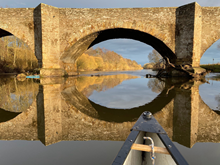22 October, 2024
Public asked for help as new beaver survey gets underway

Members of the public and landowners are being urged to report sightings and signs of beavers as part of a new survey of the population in and around Tayside.
NatureScot, Beaver Trust and the University of St Andrews are working together this autumn and winter to gather up-to-date detailed information on the locations of active beaver territories and assess the spread of the population.
Experienced beaver surveyors from the Beaver Trust will be searching on foot and by canoe across the area for signs of beavers such as burrows, dams, lodges, scent mounds, canal digging and foraging.
The field survey is the fourth of its kind and will cover areas beavers have spread to naturally from the Tay. This includes the Earn, Forth, Loch Lomond and Leven catchments, as well as parts of the Clyde catchment and some coastal catchments along the Firths of Forth and Tay.
Three previous surveys in 2012, 2017/2018 and 2020/2021 show that the Tayside population has increased from an estimated 38-39 territories and 146 beavers in 2012, to 251 territories and an estimated 954 individuals in 2020/21.
Roo Campbell, NatureScot project lead, said: “From reported sightings, we think that the population that originated in Tayside now stretches from West Lothian to Loch Lomond and right up to Crianlarich and Forfar, with a recent expansion in Fife as well.
“We estimate there has been a 30% annual increase in territories between the last two surveys, and this new, comprehensive monitoring project will give us essential up-to-date information on beaver numbers and their range. Beavers are a protected species and as such, we want to monitor their conservation status and be able to assess the impact of management measures.
“While we are taking steps to inform landowners when we are in the area, given the scale and nature of this survey, it will not be possible to contact every landowner in advance, so we would ask for their support in carrying out this essential work. We’d also encourage the public to help by reporting sightings of beavers and signs of their activity using the Mammal Society’s Mammal Mapper app or online species recording form.”
Dr Roisin Campbell-Palmer, Head of Restoration at Beaver Trust, said: "This latest survey is important because it enables us to understand, with an objective approach, how beaver territories have changed, where beavers are living and what impacts they are having.
“It will also allow NatureScot to compare the results with those of the previous survey that we ran three years ago and understand the impact of beaver management on beaver numbers and territories, to learn lessons and improve approaches to beaver management in the future."
An important part of the project being undertaken by the University of St Andrews is to use data gathered from the survey to design an effective method for monitoring and assessing beaver populations across large areas in future, as well as predicting their ongoing expansion.
Chris Sutherland, a statistical ecologist in the university’s Centre for Research into Ecological and Environmental Modelling (CREEM), said: “The ability to learn from data really boils down to the quality of the information collected. This project is another example of the University of St Andrews working closely with NatureScot to ensure that the evidence used to inform decision-making and policy is rigorous and reliable.”
For landowners with land with rivers, burns or other waterbodies in the survey area, contractors may pass across property during the course of their survey. NatureScot will be liaising with NFUS and SLE to make contact with members to inform them of survey timing.
The survey will also help anticipate where there may be a need to inform and advise land managers on approaches to living with beavers and NatureScot encourages landowners to support the work of the surveyors. Anyone with concerns about the survey taking place on their land can contact BEAVERS@nature.scot.
ENDS
Contact information
- Name
- NatureScot Media
- Telephone
- 0131 316 2655
- media@nature.scot
Notes to editors
The field survey will not include catchments where there are smaller or more recently established beaver populations and their range and size is better known. This includes Knapdale, where beavers have been present since the Scottish Beaver Trial in 2009 and have been subsequently reinforced by translocations by Forestry and Land Scotland; the Spey catchment, where translocations began in late 2023 led by the Cairngorms National Park Authority; and the Beauly catchment, where a small number of beavers are known to live, thought to be escapees from captive collections.
Media Contacts:
NatureScot - Media Team on 0131 316 2655 or MEDIA@nature.scot.
Beaver Trust - Emily Bowen, Communications Officer at Beaver Trust, emily@beavertrust.org or 07771 867 060.
University of St Andrews – Communications Team on communications@st-andrews.ac.uk.
About Beaver Trust
Beaver Trust is a nature restoration charity restoring beavers to regenerate our landscapes. They provide practical solutions to help people live alongside beavers and support legislation that rebuilds ecosystems and strengthens climate resilience in a time of ecological and climate crisis. For more information visit beavertrust.org
NatureScot is Scotland's nature agency. We work to enhance our natural environment in Scotland and inspire everyone to care more about it. Our priority is a nature-rich future for Scotland and an effective response to the climate emergency. For more information, visit our website at www.nature.scot or follow us on X at https://x.com/NatureScot
’S e NatureScot buidheann nàdair na h-Alba. Bidh sinn a’ neartachadh àrainneachd na h-Alba agus a’ brosnachadh dhaoine gu barrachd suim a chur ann an nàdar. Tha e mar phrìomhachas againn gum bi nàdar na h-Alba beairteach agus gun dèilig sinn gu h-èifeachdach le èiginn na gnàth-shìde. Tha an tuilleadh fiosrachaidh aig www.nature.scot no air X aig https://x.com/NatureScot



